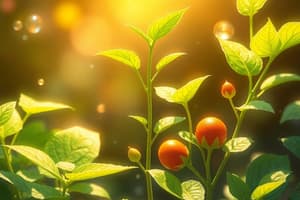Podcast
Questions and Answers
What term describes organisms that rely on consuming organic matter for their nutrition?
What term describes organisms that rely on consuming organic matter for their nutrition?
- Autotrophs
- Anaerobes
- Photoautotrophs
- Heterotrophs (correct)
Which type of organism is able to perform both photosynthesis and consume organic material based on light availability?
Which type of organism is able to perform both photosynthesis and consume organic material based on light availability?
- Euglena (correct)
- Carnivorous plants
- Chemotrophs
- Chemoautotrophs
What is the primary organic substance produced during photosynthesis?
What is the primary organic substance produced during photosynthesis?
- Oxygen
- Glucose (correct)
- Carbon dioxide
- Nitrogen
What classification do humans fall under regarding their nutritional needs?
What classification do humans fall under regarding their nutritional needs?
Which type of autotroph uses chemical reactions to derive energy?
Which type of autotroph uses chemical reactions to derive energy?
What is a characteristic feature of photoheterotrophs?
What is a characteristic feature of photoheterotrophs?
Where are chemoautotrophs typically found?
Where are chemoautotrophs typically found?
Why are nitrogen levels significant for carnivorous plants?
Why are nitrogen levels significant for carnivorous plants?
Flashcards are hidden until you start studying
Study Notes
Animal and Plant Nutrition
- Favorite animals can vary widely; examples include velvet ants, sea pigs, and silkie bantam chickens.
- Key nutritional classification includes herbivores (plant-eaters), carnivores (meat-eaters), and omnivores (both).
- Animals and fungi are heterotrophs, relying on the consumption of organic matter.
- Heterotrophs, often referred to as consumers, include various life forms like some protists, bacteria, and Archaea.
Autotrophs and Photosynthesis
- Most plants are autotrophs, producing their own food via photosynthesis, converting inorganic substances (like carbon dioxide) into organic substances (like glucose).
- Glucose is the primary organic substance produced during photosynthesis.
- Carnivorous plants can digest insects to obtain nitrogen while still producing food through photosynthesis.
- Nitrogen is crucial for living organisms, especially in nitrogen-deficient soil where many carnivorous plants thrive.
- Some protists and specific bacteria and Archaea also function as autotrophs.
Dual Nutrition in Organisms
- Euglena is an example of an organism that can be both autotrophic (through photosynthesis) and heterotrophic (consuming organic matter) depending on light availability.
- While autotrophs create their food from inorganic sources, heterotrophs must consume organic sources.
Energy Sources for Organisms
- Autotrophs can be classified further based on their energy sources: photoautotrophs (using light) and chemoautotrophs (using chemical reactions).
- Photoautotrophs like plants utilize light to create food, while chemoautotrophs, such as certain bacteria near deep-sea vents, derive energy from chemical oxidation.
- Chemoautotrophs can thrive in extreme environments with no light, utilizing available inorganic compounds.
Human Nutrition Classification
- Humans are categorized as chemoheterotrophs, needing to consume organic matter and deriving energy from organic compounds.
Additional Nutritional Types
- Photoheterotrophs are heterotrophs that consume organic matter but rely on light as their energy source, primarily found in some prokaryotes.
- All organisms engage in cellular respiration to break down food and generate ATP, regardless of whether they are autotrophs or heterotrophs.
Conclusion
- The diversity of nutritional strategies among organisms is fascinating, showcasing a range of adaptations for survival in various environments.
Animal and Plant Nutrition
- Nutritional classifications include herbivores (plant-eaters), carnivores (meat-eaters), and omnivores (both).
- Animals and fungi are heterotrophs, relying on organic matter consumption for nutrition.
- Heterotrophs also encompass certain protists, bacteria, and Archaea, often considered as consumers.
Autotrophs and Photosynthesis
- Autotrophs, primarily plants, produce their own food through photosynthesis by converting carbon dioxide and water into glucose.
- Glucose serves as the main organic compound generated during photosynthesis.
- Carnivorous plants, such as the Venus flytrap, supplement their nutrient intake by digesting insects for nitrogen while still performing photosynthesis.
- Nitrogen is essential for organisms, particularly in nutrient-poor soils where carnivorous plants thrive.
- Some protists, bacteria, and Archaea also function as autotrophs.
Dual Nutrition in Organisms
- Euglena can switch between autotrophic (photosynthesis) and heterotrophic (organic matter consumption) modes depending on available light.
- Autotrophs synthesize food from inorganic substances, while heterotrophs require organic substances for their energy needs.
Energy Sources for Organisms
- Autotrophs are further divided into photoautotrophs (using light for photosynthesis) and chemoautotrophs (using chemical reactions).
- Photoautotrophs, such as plants, harness sunlight to produce energy, while chemoautotrophs, like those found near deep-sea hydrothermal vents, utilize inorganic chemical reactions.
- Chemoautotrophs can exist in extreme, light-less environments by metabolizing inorganic compounds.
Human Nutrition Classification
- Humans are classified as chemoheterotrophs, requiring the consumption of organic matter to obtain energy and nutrients.
Additional Nutritional Types
- Photoheterotrophs consume organic matter while depending on light for energy, typically observed in some prokaryotic organisms.
- Cellular respiration is a universal process in all organisms, allowing them to break down food and produce ATP for energy, no matter their nutritional type.
Conclusion
- The variety of nutritional strategies among organisms highlights numerous adaptations that facilitate survival across diverse environments.
Studying That Suits You
Use AI to generate personalized quizzes and flashcards to suit your learning preferences.




